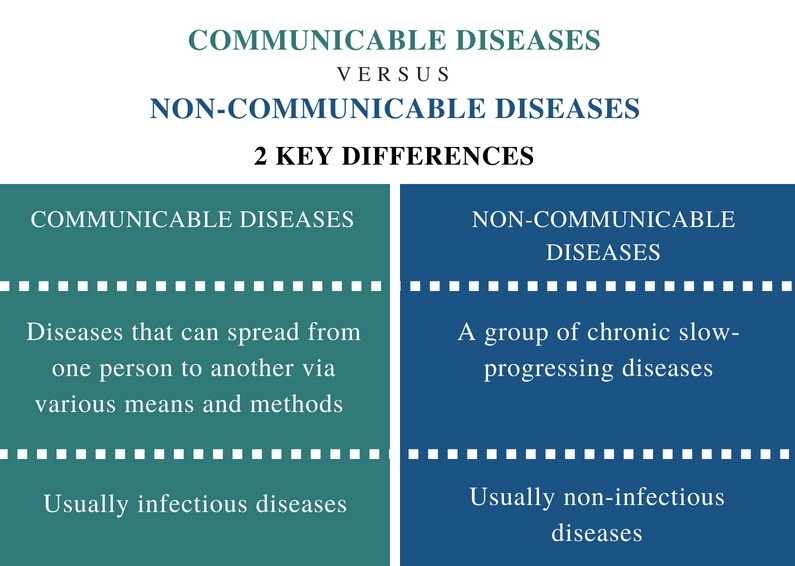
What is the difference between Communicable and Non-Communicable Diseases?
What is the difference between Communicable and Non-Communicable Diseases?
You all wants to know What is the difference between Communicable and Non-Communicable Diseases?
As we know COVID-19 cases in India and in the whole world are rising. On 25 March 2020, cases of COVID-19 rise to 562. Do you know COVID-19 is a communicable or non-communicable disease? What is a communicable and non-communicable disease? Let us have a look in detail!
Coronavirus pandemic cases are increasing due to several reasons. It spreads from person to person through the droplets of an infected person via coughs or exhales.
In fact, these droplets land on objects and surfaces around the person or in the surrounding. If other people touch these objects or surfaces then the virus will enter that person’s body via hands, etc. Because of these reasons, it is important to stay more than 1 meter away from a person who is sick or infected. Still, research is going on to understand more about the virus and its spread.
So, COVID-19 is a communicable disease or non-communicable? Let us find out!
What is a communicable disease?
Communicable diseases spread by an infectious agent like bacteria, virus, fungi, or parasites. You might have read or listened to words ‘contagious’ or ‘infectious’ are used for communicable diseases because it can be passed from person to person. For example, malaria, AIDS, etc. There are various reasons for the spread of communicable diseases. It can be spread through the air, by direct contact with the contaminated surface, food or beverage, blood or other bodily fluid. It has also seen that sometimes a bite from an infected animal or insect can spread the disease. And some diseases are also transmitted in more than one way.
Where the cases of communicable diseases are reported planning, evaluation of disease prevention and control programs, appropriate medical therapy and detection of common-source of an outbreak is important. Therefore, we can say that COVID-19 is a communicable disease.
COVID-19 Pandemic: 13 Myths And Facts About Coronavirus
Some healthy habits are recommended for communicable diseases to avoid germs and from spreading:
– Prepare food safely and handle it safely.
– Frequently it is necessary to wash hands.
– Clean and make disinfect the touched surfaces so that germs are killed.
– It is necessary to cover cough and sneeze with a tissue.
– Don’t share personal items.
– Get vaccinated.
– Avoid touching wild animals.
– If you are sick, stay home. Avoid spreading germs.
Now let us study about non-communicable diseases.
What are non-communicable diseases?
Non-communicable disease (NCD) is also called a chronic disease that last for long duration and are a result of a combination of several factors including genetic, physiological, environmental and behaviours.
We can say that non-communicable as the name suggests are the diseases that are not transmitted from one person to another person. It is a non-infectious disease. They can be allergies, nutrient deficiencies, etc.
Who are at risk for such diseases?
People of all age groups, regions and counties are affected by non-communicable diseases. With the older age groups might be these conditions are often associated, but according to the data of WHO 15 million deaths attributed to non-communicable diseases occur between the ages of 30 and 69 years. Over 85% of premature deaths are estimated to occur in low and middle-income countries. Due to unhealthy diets, physical inactivity, exposure to tobacco smoke or use of alcohol anyone can be affected whether children, adults and the elderly.
Why are Ventilators important to fight COVID-19?
How are non-communicable diseases prevented and controlled?
One of the important ways to control non-communicable diseases is to focus on reducing the risk factors associated with these diseases. A need of comprehensive approach for all sectors including health, finance, transport, education, agriculture, planning and others, to collaborate the risks associated with non-communicable diseases and promote interventions to prevent and control them.
Management of non-communicable diseases is also important like detecting, screening and treating these diseases and providing access to the people in need. Proper health care approach, so that the disease is detected at the primary level and for timely treatment.
It is essential for the non-communicable disease management to achieve the global target of a 25% relative reduction in the risk of premature mortality from non-communicable diseases by 2025 and the SDG target of a one-third reduction in premature deaths from non-communicable diseases by 2030. Non-communicable diseases can be chronic diseases, cardiovascular diseases, respiratory tract diseases, etc.
So now you may have understood about communicable and non-communicable diseases.
Reference : Jagran Josh
#WhatisthedifferencebetweenCommunicableandNonCommunicableDiseases #Covid_19 #CoronaVirus

What is the difference between Communicable and Non-Communicable Diseases?


